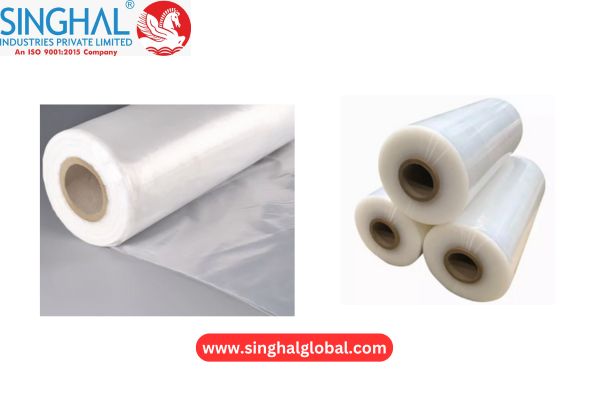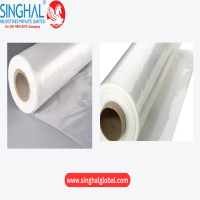PE Film for Industrial Use: A Comprehensive Guide

Strong 8k brings an ultra-HD IPTV experience to your living room and your pocket.
Polyethylene (PE) film is one of the most widely used materials in various industries due to its versatility, durability, and cost-effectiveness. PE films are made from polyethylene, a thermoplastic polymer, and they serve a multitude of applications ranging from packaging, construction, and agriculture to electronics and medical industries. This article explores the benefits of PE film for industrial use, key types of PE film material, and factors to consider when choosing a PE film supplier.
What is PE Film?
Polyethylene (PE) film is a thin layer of plastic material derived from petroleum or natural gas. Its popularity stems from its lightweight nature, high resistance to moisture, chemicals, and environmental factors. These attributes make PE films suitable for protecting and packaging a wide variety of products. PE films are commonly used in industrial applications to wrap, package, or protect items during transportation and storage.
Types of PE Film Material
PE films can be classified into several types based on their chemical structure and density. The most common types of PE film include:
Low-Density Polyethylene (LDPE) Film LDPE film is known for its flexibility, clarity, and softness. It is commonly used for applications requiring a stretchable and moisture-resistant material, such as food packaging, shrink wraps, and garment bags. LDPE is ideal for lightweight applications but provides limited strength and durability.
High-Density Polyethylene (HDPE) Film HDPE film is denser and stronger than LDPE, making it suitable for industrial applications that require higher tensile strength. It is used in heavy-duty packaging, construction materials, and liners. HDPE film also offers superior resistance to punctures and tears, making it ideal for applications where durability is key.
Linear Low-Density Polyethylene (LLDPE) Film LLDPE film is a blend of LDPE and HDPE properties, providing both flexibility and strength. It is used for stretch films, agricultural films, and industrial packaging. LLDPE has a higher tensile strength than LDPE and is more cost-effective than HDPE, making it a popular choice for wrapping and palletizing products.
Metallocene PE (PE) Film PE film is made using metallocene catalysts, offering enhanced clarity, puncture resistance, and sealing properties. It is widely used in high-performance packaging, especially in food and medical industries. PE films are valued for their superior strength and flexibility, allowing for thinner films without sacrificing durability.
Benefits of PE Film for Industrial Use
PE films are favored in industrial applications for several key reasons:
Durability and Strength PE films offer excellent resistance to tearing, punctures, and environmental factors such as UV rays, moisture, and chemicals. This makes them ideal for heavy-duty applications where protection and longevity are essential.
Versatility PE films can be used across a wide range of industries, from food packaging and agricultural covering to construction sheeting and protective wraps for electronics. The wide variety of PE film types allows for customization to specific industrial needs.
Cost-Effective Polyethylene is an affordable material, making PE films an economical solution for industries looking for reliable packaging and protection without exceeding budget constraints. The versatility of the film also means that one type of PE film can serve multiple functions, further reducing costs.
Environmental Resistance The chemical structure of PE film makes it highly resistant to moisture, chemicals, and other environmental factors. It offers a protective barrier that keeps products safe from damage, contamination, and external influences during storage or transportation.
Lightweight Despite its strength, PE film is extremely lightweight, which reduces transportation costs. This feature also makes it easy to handle and apply in industrial settings.
Factors to Consider When Choosing a PE Film Supplier
Selecting the right PE film supplier is critical to ensuring that you receive high-quality materials suited for your specific industrial needs. Here are some factors to consider:
Quality Assurance A reputable PE film supplier should offer products that meet industry standards and regulatory requirements. Ask about the supplier's quality control measures and certifications to ensure that the PE film you receive is consistent and reliable.
Customization Options Different industries have varying requirements for PE films in terms of size, thickness, and performance. A supplier that offers customization services can tailor the film to your exact specifications, providing you with the best solution for your application.
Material Variety Your supplier should offer a range of PE film materials, including LDPE, HDPE, LLDPE, and mPE, to ensure you have access to the most suitable film for your specific use case. Having multiple options will allow you to find the right balance of cost, durability, and flexibility.
Technical Support A good supplier should provide technical support and guidance, helping you select the right film for your industrial needs. This can include advising on film properties, customization options, and application methods.
Sustainability Initiatives As industries become more focused on sustainability, it’s important to choose a PE film supplier that offers environmentally friendly options. Look for suppliers who provide recyclable or biodegradable PE films and are committed to reducing their environmental footprint.
Conclusion
PE film is an indispensable material in many industrial applications due to its strength, versatility, and cost-effectiveness. Whether you need LDPE for flexible packaging or HDPE for heavy-duty industrial uses, choosing the right type of PE film material is key to ensuring optimal performance. Working with a reliable PE film supplier that offers quality products, customization options, and technical support can help meet your specific industrial needs while also aligning with sustainability goals.
By understanding the various types of PE films and their benefits, industries can make informed decisions and leverage the full potential of PE film for their operations.
FAQs: PE Film
What is PE film used for?
PE film is used in packaging, construction, agriculture, electronics, and medical industries for wrapping, protection, and insulation.
What are the types of PE film?
Common types include LDPE (Low-Density), HDPE (High-Density), LLDPE (Linear Low-Density), and mPE (Metallocene Polyethylene).
What are the benefits of PE film?
PE films are durable, cost-effective, lightweight, and resistant to moisture, chemicals, and environmental factors.
How do I choose the right PE film supplier?
Look for suppliers offering quality assurance, customization options, material variety, and technical support.
Note: IndiBlogHub features both user-submitted and editorial content. We do not verify third-party contributions. Read our Disclaimer and Privacy Policyfor details.


